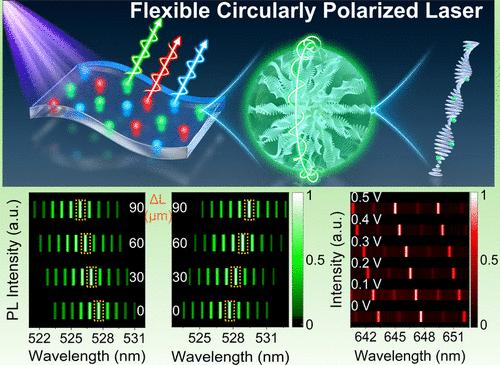Electrically Tunable Flexible Circularly Polarized Laser with Ultrahigh Asymmetry Factor
IF 16
1区 材料科学
Q1 CHEMISTRY, MULTIDISCIPLINARY
引用次数: 0
Abstract
Circularly polarized (CP) laser emission delivers considerable promise for future photonic applications of chiral light sources and investigation of chiral light–matter interactions. However, the low asymmetry factor (glum) and lack of effective tuning have significantly hindered the development of such chiral light sources. Herein, multicolor (blue, green, and red) flexible CP lasers are demonstrated based on dye-doped cholesteric liquid crystal (CLC) microdroplets embedded in a polydimethylsiloxane (PDMS) elastomer. The CLC microdroplets, characterized by their left- or right-handed helical superstructures, serve as chiral cavities, facilitating the realization of CP lasing. By integrating chiral coating, CP lasing with opposite handedness is further effectively separated, notably enhancing the circular polarization degree and enabling an ultrahigh asymmetry factor (glum = 1.72). Importantly, these flexible CP lasers exhibit both electrically and mechanically tunable emission, demonstrating excellent wavelength tunability. In addition, the applied electric field allows dynamic control over the laser emission intensity, enabling fully reversible on/off switching. This work represents an important step forward to the development of high-performance chiral light sources with facile tunability and offers valuable insights for future chiroptical device design.

具有超高不对称系数的电调谐柔性圆偏振激光器
圆偏振(CP)激光发射为未来手性光源的光子应用和手性光-物质相互作用的研究提供了可观的前景。然而,低不对称系数(glum)和缺乏有效调谐严重阻碍了这种手性光源的发展。本文演示了基于嵌入聚二甲基硅氧烷(PDMS)弹性体中的染料掺杂胆固醇酯液晶(CLC)微滴的多色(蓝、绿、红)柔性CP激光器。CLC微滴具有左旋或右旋螺旋超结构,可作为手性空穴,促进了CP激光的实现。通过整合手性涂层,进一步有效地分离了具有相反手性的CP激光,显著提高了圆偏振度,实现了超高的不对称系数(glum = 1.72)。重要的是,这些柔性CP激光器具有电和机械可调谐的发射特性,具有出色的波长可调谐性。此外,外加电场允许对激光发射强度进行动态控制,从而实现完全可逆的开/关开关。这项工作代表着向高性能手性光源的发展迈出了重要的一步,并为未来的手性器件设计提供了有价值的见解。
本文章由计算机程序翻译,如有差异,请以英文原文为准。
求助全文
约1分钟内获得全文
求助全文
来源期刊

ACS Nano
工程技术-材料科学:综合
CiteScore
26.00
自引率
4.10%
发文量
1627
审稿时长
1.7 months
期刊介绍:
ACS Nano, published monthly, serves as an international forum for comprehensive articles on nanoscience and nanotechnology research at the intersections of chemistry, biology, materials science, physics, and engineering. The journal fosters communication among scientists in these communities, facilitating collaboration, new research opportunities, and advancements through discoveries. ACS Nano covers synthesis, assembly, characterization, theory, and simulation of nanostructures, nanobiotechnology, nanofabrication, methods and tools for nanoscience and nanotechnology, and self- and directed-assembly. Alongside original research articles, it offers thorough reviews, perspectives on cutting-edge research, and discussions envisioning the future of nanoscience and nanotechnology.
 求助内容:
求助内容: 应助结果提醒方式:
应助结果提醒方式:


